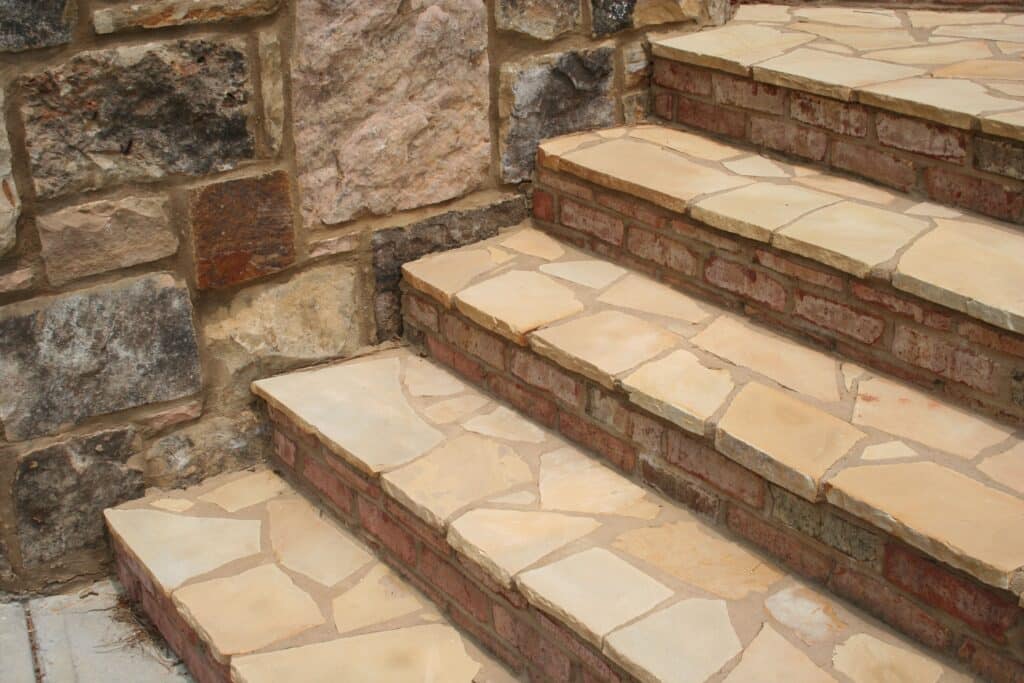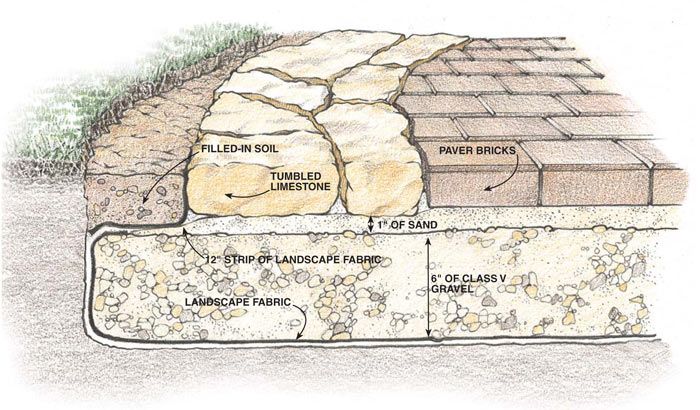
ʻO ka pōhaku hae kekahi o nā pōhaku pālahalaha maʻamau. Manaʻo ʻia ʻo ia ka conveyor hoʻomau maikaʻi loa o ka ʻoiaʻiʻo i kāu hoʻolālā ʻāina.
ʻO kahi kumu paʻa ma hope o kēia ke hoʻohana ʻoe i kēia mau papa nā pōhaku, e hana ʻoe i kahi manaʻo i hana lima ʻia i kou pā hale e nānā mau ʻole. ʻOiai he nui nā ʻano like ʻole o nā pōhaku hae i ʻoki ʻia i kēia wā a me ka rustic, hiki iā ʻoe ke hoʻopuka i kou ʻono a me kou ʻano.
In this blog, you will first get to know the origins of this flagstone and learn about its creation. Afterward, you’ll learn about the different types and the best practices for using them. At length, you’ll gain valuable knowledge in the art and science of installing this material.
Flagstone is a generic term for many different types of rock. In the beginning, a stonemason chisels or strikes larger stones. And as a result, it breaks up into thick, flat sheets. Next, these thinner sheets are then broken up into flagstone-sized pieces. There are abundant varieties of rock that masons cut and then shape into flagstones.
I ka hoʻomaka ʻana, ʻo nā pōhaku palupalu a maʻalahi loa e ʻoki ʻia i ke ʻano he pōhaku sedimentary, me nā ʻano like ʻole e like me ke one, shale, a me ka limestone.
ʻO ka lua, ʻo nā ʻano ʻano paʻakikī e like me ka granite a i ʻole basalt. ʻO ka mea hope loa, ʻo nā ʻano ʻoi loa ka paʻakikī o nā pōhaku metamorphic, e like me ka quartzite a me ke kinikini.
ʻElua mau ʻano nui i makemake ʻia Flagstones: patio and select. Comparatively, Patio pieces type of Flagstone is smaller, ranging from 12” to 18” and thicker. And are most often used for stepping stones, outdoor pathways, or patios. Due to their smaller size, they are typically palletized lying down, preventing breakage during shipment. Contrarily, select flagstone, known as “standup,” comes in large, thin slabs of 18” to 36”. Due to their large size, they are usually palletized vertically. Flagstones generally make the formation of many shapes and sizes, including rectangular and square. Nevertheless, they are also available in more natural, jagged varieties.

For more than hundreds of thousands of years, Flagstone has been used in various types of formation. Earlier in the 1900s, people saw it as an improvement over cobblestone, and it’s easy to see why. Whereas stonemasons can chisel it at ease by hand into a very flat surface, it is a simple way to create a flat paving surface. Its notable usages as countertop material or even as a paving substrate and as a walkway or roadway. People even use them as roofing and siding. Flagstone patios and Stepping stones are the most common applications of flagstones.

Hoʻohana pinepine mākou i ke one ma ke ʻano he kumu no nā pōhaku hae. ʻO ka mea mua, he maʻalahi loa ka hoʻouka ʻana o Sand a hāʻawi i kahi pono hoʻokahe wai nui. Eia kekahi, e kōkua pū lākou i ka pale ʻana i ka nahele a me ka ulu ʻana o nā mea kanu ma waena o kāu mau pōhaku. Eia naʻe, no ka hoʻokomo mau ʻana, e hoʻohana i ka sima. Me kahi kumu one, pono ʻoe i ka pōhaku hae mānoanoa. ʻAe ʻo Mortar iā ʻoe e hoʻohana i nā pōhaku ʻoi aku ka liʻiliʻi no ka mea kōkua ke kumu sima i ka hoʻoikaika ʻana i ka ʻili.

ʻO ka mea maikaʻi loa e pili ana i kēia pōhaku maoli, hiki iā ʻoe ke hana i nā ʻano like ʻole like ʻole! ʻO ka mea like, ʻo ka palena wale nō kou noʻonoʻo me kēia mea. No ka hoʻokaʻawale ʻana i kāu hiʻohiʻona, ʻoiaʻiʻo, ʻo nā mea āpau āu e hana ai, ʻo ka hoʻopaʻa ʻana i kāu ʻāina. He mea maʻalahi kēia inā makemake ʻoe i kahi hiʻohiʻona hou a maʻemaʻe, pono ʻoe e hoʻopaʻa i kahi ʻano paʻa hou aʻe. Ma ka ʻaoʻao ʻē aʻe, hiki iā ʻoe ke hele no nā ʻano like ʻole a me nā ʻano like ʻole no kahi hiʻohiʻona rustic a kūlohelohe.

Makemake paha ʻoe i nā pōhaku hae no nā kumu he nui, me, Nā pōhaku hae which are naturally flat, and it’s easy to use in so many different projects.
However, because flagstone is more of a generic term for many sedimentary rocks, it’s easy to misunderstand and underappreciate.
Eia kekahi mau mea pono ʻoe e ʻike e pili ana:
Flagstone’s one of the beneficial advantages is that it’s relatively flat when mined, making it ideal in so many landscaping projects.
Second, it’s naturally non-slip. Whenever you are all set to starting a project where people will need to walk, a non-slip surface is essential for safety. Next, it’s strong and stable. When installed properly, it won’t break or crack.
ʻO ka maʻamau, hiki iā ʻoe ke loaʻa nā ʻano kikoʻī a i ʻole nā hue o Nā pōhaku hae a hoʻohana i kekahi o nā aka. ʻOiai ʻo ka hapa nui o nā aka hina a ʻeleʻele paha e like me ka hapa nui o ka pōhaku, hiki i nā aka he nui ke loaʻa nā ʻulaʻula, ʻōmaʻomaʻo, ʻulaʻula, gula, a kokoke i ke keʻokeʻo.
ʻO ia ke ʻano hiki iā ʻoe ke ʻimi a koho i kahi pōhaku hae e hoʻohui a hoʻohālikelike paha iā ia, ʻo ia kāu pahuhopu, ʻaʻohe o nā kala e hoʻopili ʻia a puni kou home.
ʻO ka mea nui, hiki iā ʻoe ke kiʻi i kahi hui maʻalahi o nā pōhaku me nā kala he nui a hana i kahi patio hoʻokahi a i ʻole ala hele wāwae.
Hiki ke manaʻo ʻia ka maʻalahi o ka hoʻonohonoho ʻana i kekahi o kāna mau pono. No ke kau ʻana i ka patio, makemake paha ʻoe e noʻonoʻo e hoʻokomo iā ia me ka mortar ma waena o nā pōhaku. E hāʻawi maoli kēia i kou pā hale i ka pae piha a me ka manaʻo paʻa, kūpono no nā noho a me nā papaʻaina.
Suppose you’re planning to construct a walkway across your lawn. You can install large stones directly on your dirt and install mulch or allow the grass to grow around it.
As an alternate, you can also create a walking path with gravel between the stones. It’s also a great option for building stairs. Nevertheless, you would want to use cement to ensure safety and stability.
From our long-entailed informative blog, we hope we have provided you a clear conception of how, no matter what project you’re planning, there are ways to incorporate this beautiful stone.